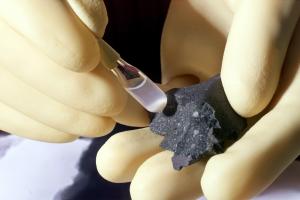Key To Life Before Its Origin On Earth May Have Been Discovered
 An important discovery has been made with respect to the mystery of "handedness" in biomolecules. Researchers led by Sandra Pizzarello, a research professor at Arizona State University, found that some of the possible abiotic precursors to the origin of life on Earth have been shown to carry "handedness" in a larger number than previously thought.
An important discovery has been made with respect to the mystery of "handedness" in biomolecules. Researchers led by Sandra Pizzarello, a research professor at Arizona State University, found that some of the possible abiotic precursors to the origin of life on Earth have been shown to carry "handedness" in a larger number than previously thought.
Pizzarello, in ASU's Department of Chemistry and Biochemistry, worked with Yongsong Huang and Marcelo Alexandre, of Brown University, in studying the organic materials of a special group of meteorites that contain among a variety of compounds, amino acids that have identical counterparts in terrestrial biomolecules. These meteorites are fragments of asteroids that are about the same age as the solar system (roughly 4.5 billion years.)
Scientists have long known that most compounds in living things exist in mirror-image forms. The two forms are like hands; one is a mirror reflection of the other. They are different, cannot be superimposed, yet identical in their parts.
When scientists synthesize these molecules in the laboratory, half of a sample turns out to be "left-handed" and the other half "right-handed." But amino acids, which are the building blocks of terrestrial proteins, are all "left-handed," while the sugars of DNA and RNA are "right-handed." The mystery as to why this is the case, "parallels in many of its queries those that surround the origin of life," said Pizzarello.
Years ago Pizzarello and ASU professor emeritus John Cronin analyzed amino acids from the Murchison meteorite (which landed in Australia in 1969) that were unknown on Earth, hence solving the problem of any contamination. They discovered a preponderance of "left-handed" amino acids over their "right-handed" form.
"The findings of Cronin and Pizzarello are probably the first demonstration that there may be natural processes in the cosmos that generate a preferred amino acid handedness," Jeffrey Bada of the Scripps Institution of Oceanography, La Jolla, Calif., said at the time.
The new PNAS work* was made possible by the finding in Antarctica of an exceptionally pristine meteorite. Antarctic ices are good "curators" of meteorites. After a meteorite falls -- and meteorites have been falling throughout the history of Earth -- it is quickly covered by snow and buried in the ice. Because these ices are in constant motion, when they come to a mountain, they will flow over the hill and bring meteorites to the surface.
"Thanks to the pristine nature of this meteorite, we were able to demonstrate that other extraterrestrial amino acids carry the left-handed excesses in meteorites and, above all, that these excesses appear to signify that their precursor molecules, the aldehydes, also carried such excesses," Pizzarello said. "In other words, a molecular trait that defines life seems to have broader distribution as well as a long cosmic lineage."" - sciencedaily
An important discovery has been made with respect to the mystery of "handedness" in biomolecules. Researchers led by Sandra Pizzarello, a research professor at Arizona State University, found that some of the possible abiotic precursors to the origin of life on Earth have been shown to carry "handedness" in a larger number than previously thought.
No comments:
Post a Comment